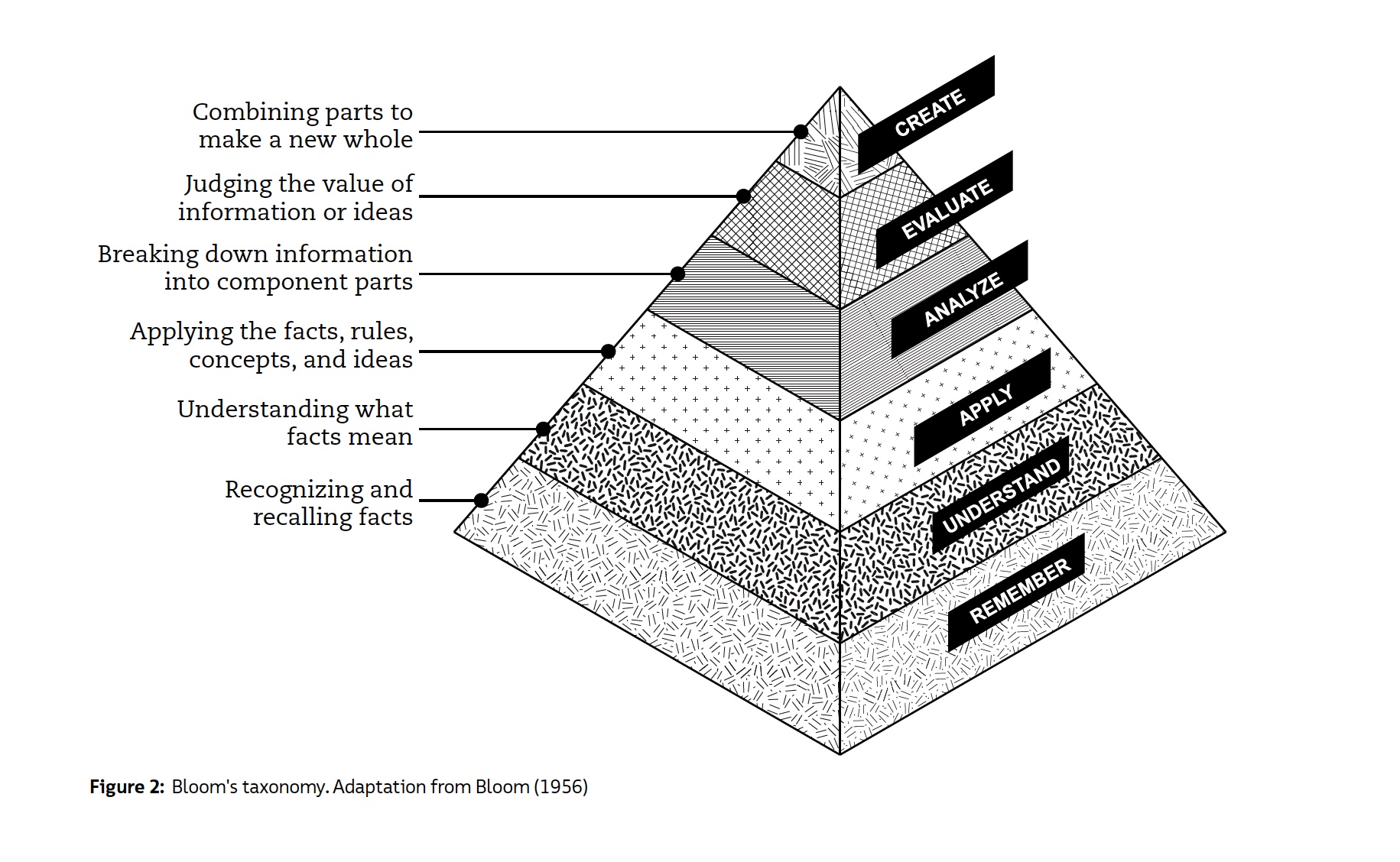Pedagogy – Critique – Transformation
Downloads
DOI:
10.31182/cubic.2021.4.033Keywords:
education models, digital pedagogies, softskills, pedagogical transformations, design education mutationsAbstract
Design education has significantly changed since the 1950s. The era depended widely on normative models such as those proposed by Benjamin Bloom (Bloom et al. 1956) and his collaborators, which resulted in the formulation of Bloom's Taxonomy. Comprising six interchangeable layers (knowledge, comprehension, application, analysis, synthesis, and evaluation) of higher and lower thinking, Bloom's taxonomy sets in place an archetypal model for education that thrives on object-driven goals. Here, pedagogical interchange and the object-driven and organised structure of education can adapt to each layer within the taxonomic structure.
How to Cite
Published
Issue
Section
References
Amabile, Teresa. “How to kill creativity.” Harvard Business Review 76, no. 5 (1998): 76-87.
Bloom, Benjamin S. Taxonomy of educational objectives: The classification of educational goals.. New York: Longmans, Green, 1956.
Blumenfeld, Phyllis, C., Elliot Soloway, Ronald W. Marx, Joseph S. Krajcik, Mark Guzdial and Annemarie Palincsar. “Motivating projectbased learning: Sustaining the doing, supporting the learning.” Educational Psychologist 26, no. 3/4 (1991): 369-398.
Broadfoot, Ouita., and Bennett, Rick. (2003). Design studios: Online? Comparing traditional face-to-face design studio education with modern internet-based design studios in Apple University consortium academic and developers conference proceedings, 2003 (pp. 9–21)
Brocato, Kay. “Studio based learning: proposing, critiquing, iterating our way to person-centeredness for better classroom management.” Theory Into Practice 48, no.2 (2009): 138-146.
Brusaco, P. L., Caneparo, L., Carrara, G., Fioravanti, A., Novembri, G., & Zorgno, A. M. (2000). Computer supported design studio, Automation in Construction, 9, 393-408
Dewey, John. Education and Experience. New York: Touchstone Edition, 1997
Dewey, John. The Collected Works of John Dewey, 1882-1953. Edited by Jo Ann Boydston. Vols 5. Carbondale and Edwardsville, IL: Southern
Illinois University Press, 1991.
Dunn, Lee Andrew. “Teaching in higher education: can social media enhance the learning experience?” Present in 6th Annual University of Glasgow Learning and Teaching Conference, Glasgow, UK, April 2013.
Evers, Chia. “The ‘Missing’ Principle: Learning Over Education.” 23 Mar 2017, https://whiplashbook.com/the-missing-principlelearning-over-education-3a7905549aae.
Floridi, Lucano. The Online Manifesto: Being Human in a Hyperconnected Era. Springer, 2015.
Franceschin, Tomas. “How can transmedia learning transform education?”. Edu4.me. 27 June 2016, accessed, http://edu4.me/en/how-can-transmedia-learning-transform-education/
Fusch, Douglas. “Social Media and Student Learning: Moving the needle on engagement.” Academic Impressions (2011):15.
Klooster, Sietske, Richard Appleby and Kees Overbeeke. “Design (education) moves.” In P. Loyd (Ed.), The changing face of design education : proceedings of the 2nd International Engineering and Product Design Education Conference, Delft University of Technology, The Netherlands, September 2-3, 2004 (pp. 257-264).
Kolb, David. Experiential learning: Experience as the source of learning and development. Englewood Cliffs, NJ : Prentice Hall, 1984.
Lloyd, Peter, Norbert Roozenburg, Chris McMahon, and Libby Brodhurst. “The Changing Face of Design Education, Proceedings of the Engineering and Product Design Education Conference”, Delft University of Technology, The Netherlands, September 2-3 (2004).
Ma, Henry. “A study of blended learning strategies for projectbased studies.” Asia Pacific Journal of Contemporary Education and Communication Technology 2, no.1 (2016): 50-57.
Manzini, Ezio. Design when Everybody Designs. Boston: MIT Press, 2015.
Neale, Mark. No Maps for These Terriotories. (2000; Vancouver, BC: Docurama, 2000), DVD
Oh, Jae-Eun. “Educators and Social media: Learning Motivators in Creative Media Courses.” Asia Pacific Journal of Contemporary Education and Communication Technology 4, no. 1 (2018): 130-138.
Reinhardt, Wolfgang, Martin Ebner, Beham Gunter and Christina Costa. “How people are using Twitter during conferences. Creativity and Innovation Competencies on the Web.” Proceeding of 5th EduMedia Conference, Salzburg, (2009): 145-156.
Serres, Michel. Thumbelina: The Culture and Technology of Millennials. Rowman & Littlefield Publishers, 2014.
Shaw, Clair. “University tutorials: using contact time to boost independent learning.” The Guardian. 2 Nov 2012. https://www.theguardian.com/higher-education-network/blog/2012/nov/02/university-tutorials-students-independent-learning.


